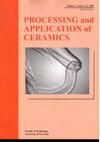Processing and electrical conductivity property of lithium-doped high-entropy pyrochlore and perovskite ceramics
IF 0.8
4区 材料科学
Q3 MATERIALS SCIENCE, CERAMICS
引用次数: 0
Abstract
Lithium-doped Li0.66La1.12(Ti0.2Zr0.2Hf0.2Sn0.2Nb0.2)2O7 (LLTNO), Li0.66La1.12(Ti0.2Zr0.2Hf0.2Sn0.2Ta0.2)2O7 (LLTTO) high-entropy pyrochlore and Li0.5Sr0.5(Ti0.2Zr0.2Hf0.2Sn0.2Ta0.2)O3 (LSTTO), Li0.5Ba0.5(Ti0.2Zr0.2Hf0.2Sn0.2Nb0.2)O3 (LBTNO) high-entropy perovskite ceramics were synthesized by solid state reaction method and sintered. Crystal structure, microstructure and electrical properties of these high entropy ceramics were studied. The LLTNO and LLTTO pellets sintered at 1300 ?C present a pyrochlore structure, while LSTTO and LBTNO pellets sintered at 1350 ?C present a perovskite structure. The LBTNO ceramics has a total conductivity of 1.25 ? 10?7 S?cm?1 at room temperature while the LSTTO sample exhibits the highest conductivity of 2.11 ? 10?7 S?cm?1 among all samples. Both LSTTO and LBTNO ceramics present negligible electronic conductivity. Relative densities of the LLTNO, LLTTO, LSTTO and LBTNO ceramics were 82, 88, 86 and 87%TD, respectively, which is the reason for low conductivity of these high entropy ceramics. The activation energies of the LSTTO and LBTNO samples were 0.39 and 0.38 eV, respectively, which is close to the traditional Li+-type conducting solid electrolytes.掺锂高熵焦绿石和钙钛矿陶瓷的制备及其导电性
采用固相法合成了掺杂锂的Li0.66La1.12(Ti0.2Zr0.2Hf0.2Sn0.2Nb0.2)2O7 (LLTNO)、Li0.66La1.12(Ti0.2Zr0.2Hf0.2Sn0.2Ta0.2)2O7 (LLTTO)高熵焦绿石和Li0.5Sr0.5(Ti0.2Zr0.2Hf0.2Sn0.2Ta0.2)O3 (LSTTO)、Li0.5Ba0.5(Ti0.2Zr0.2Hf0.2Sn0.2Nb0.2)O3 (LBTNO)高熵钙钛矿陶瓷,并进行了烧结。研究了这些高熵陶瓷的晶体结构、微观结构和电学性能。在1300℃烧结的LLTNO和LLTTO球团呈焦绿石结构,而在1350℃烧结的LSTTO和LBTNO球团呈钙钛矿结构。LBTNO陶瓷的总电导率为1.25 ?10 ?7 S厘米?室温下,LSTTO样品的电导率最高,为2.11 ?10 ?7 S厘米?在所有样本中为1。LSTTO和LBTNO陶瓷的电导率都可以忽略不计。LLTNO、LLTTO、LSTTO和LBTNO的相对密度分别为82%、88%、86%和87%TD,这是这些高熵陶瓷电导率低的原因。LSTTO和LBTNO样品的活化能分别为0.39和0.38 eV,与传统的Li+型导电固体电解质接近。
本文章由计算机程序翻译,如有差异,请以英文原文为准。
求助全文
约1分钟内获得全文
求助全文
来源期刊

Processing and Application of Ceramics
MATERIALS SCIENCE, CERAMICS-
CiteScore
1.90
自引率
9.10%
发文量
14
审稿时长
10 weeks
期刊介绍:
Information not localized
 求助内容:
求助内容: 应助结果提醒方式:
应助结果提醒方式:


